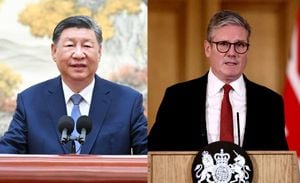Recent developments surrounding the Ukraine-Russia war showcase yet another dramatic escalation, marked by the deployment of new long-range missiles and increasing tensions. This week has seen Ukraine utilize British-made Storm Shadow missiles to target Russian territories, signaling a bold shift orchestrated by Western support.
On the heels of this, President Joe Biden granted Ukraine permission to strike inside Russia using American-made ATACMS missiles. The dynamism of this military offensive was amplified when Ukraine reportedly launched these missiles against military targets deep within Russian territory, delivering not just physical damage but also psychological impacts. The missile strikes reportedly targeted ammunition depots located within Russia's Bryansk region, marking the first major use of American long-range systems against Russian soil and raising the stakes of what has already been over two and half years of tumultuous conflict.
Meanwhile, Russian President Vladimir Putin announced the necessity of developing and mass-producing hypersonic ballistic missiles following Ukraine's use of Western missiles. He proclaimed, “There are currently no means of countering such a missile, no means of intercepting it, in the world.” Putin underscored Russia's intentions openly, stating this new missile system could not only target Ukraine but other nations supporting Ukrainian military actions as well.
The conflict reached another tipping point this week as close to 10,000 North Korean troops reportedly arrived to bolster Russian forces, raising alarms among American and British intelligence agencies. The incorporation of foreign troops on behalf of Russia amplifies the conventional account of escalation, infusing it with geopolitical complexity.
Images circulating social media have depicted alleged debris from Storm Shadow missiles found scattered across Russia's Kursk region, leading to speculation of the extent of damage caused by Kyiv's newfound offensive capabilities. Pro-Russian channels on platforms like Telegram showcased video recordings of missile strikes, punctuated by rumbles of explosions sending dark smoke billowing over the horizon.
John Healey, the UK Defense Secretary, did not refute claims of missile deployment, stating instead, “We as a nation and government are doubling down on our support for Ukraine.” The reality on the ground is changing at breakneck speed; the international community watches as both sides ramp up their military capacities.
Looking back at the broader scope of the week, the culmination of events demonstrates how closely intertwined U.S. foreign policy and battlefield dynamics have become. Since the U.S. eased restrictions on the use of ATACMS, Ukraine has firmly established its right to operate these advanced systems, effectively reshaping the nature of warfare.
Putin's response to Ukraine's actions was immediate and severe. His government launched airstrikes using the Oreshnik missile, flaunting its ability to evade advanced missile defense systems at mind-boggling speeds of up to ten times the speed of sound. This combination of bold claims from Moscow, as showcased during Putin's defense ministry meeting, outlines the increasingly perilous face-off between the Western coalition supporting Ukraine and the Russian military.
Simultaneously, the Kremlin is also revisiting its nuclear posture. On Tuesday, Putin lowered the threshold concerning nuclear weapon deployment, hinting at potential consequences should Ukraine, with Western backing, strike against Russian targets. He affirmed, “This will not be the last time I will need to make difficult decisions.” This stance may serve as both intimidation and justification for heightened military initiatives.
Friday saw NATO issuing calls for emergency meetings. The urgency is underscored by fears surrounding heightened threats on Ukrainian government infrastructures, which parallel the closing of U.S. embassies amid rising risks of air attacks.
The patterns of missile exchanges and military mobilizations paint a troubling picture. The week has been characterized not merely by individual battles but also by shifting geopolitical alliances and aspirations. European allies are reconsidering their stance on arms supply, with the French foreign minister stating there would be no “red lines” on supporting Ukraine against Russia, bolstering the resolve among Western nations.
The stakes could not be higher as international actors grapple with the existing balance of power. Ukrainian President Volodymyr Zelenskyy expressed optimism about the possibility of ending the war by 2025 but acknowledged the challenges presented by Russia's indifference to peace talks.
Putin’s rhetoric, combined with North Korean troop involvement and nuclear escalation threats, paints this conflict as one driven not just by national interest but also responsive to the theater of international diplomacy. It’s evident now more than ever, the missiles exchanged may not just be announcements of warfare; they could trap nations within broader, long-lasting consequences.
Public perception of military engagements often focuses on battlefield outcomes; yet, this week reinforces how high-stakes diplomacy plays out with missiles falling just as much as at conferences and summits across the globe. While some fighters hope for finalities within military engagements, the overarching uncertainties continuously loop the global community back to negotiations steeped with unpredictability.
At this juncture, it’s clear; the tempo of military engagement has heightened significantly, and each new launch, each round of negotiations, and every word spoken by leaders weighs heavily on the continuation of this tumultuous saga.



